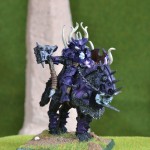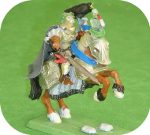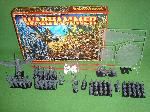
Mastering the close combat phase in Warhammer 8th edition Fantasy Battles can be seen in 3 phases. The first phase is to learn the basic mechanics of the close combat phase. The rule book does a very good job of leading you through the close combat rules, so I recommend that you read and practice this as a first step. The second phase of becoming a master of close combat in Warhammer 8th edition, is to become a master of how to assault different army formations to get the best results. The third and last phase is knowing how to arrange your units to avoid all the pitfalls that you have discovered as you where mastering how to assault your opponents formations. For this reason I will be concentrating on the second phase of mastering the close combat phase here.
Start at the End
This may seem odd. But once you have mastered the basics of the close combat phase, the best way to formulate strategies to use in the close combat phase, is to start with how you would like the combat to conclude and then work backwards planning different ways you can reach your goal or goals.
The Panic Test
In a pefect close combat, the best possible result to cause a panic test on as many units as possible by wiping out a unit in 6″ (15cm) of lots of other units. The easiest way to achieve this is to hit a relatively small unit with a much larger one. This will give you the best chance of wiping the enemy squad in a total annihilation.
Another option is to assault with two units at the same time. This will apply the greatest pressure to the enemies weakest spot. If you have read Sun Tzu’s art of war, you will see that this follows one of his main principles.
If you can not wipe out a unit, causing a unit to flee is almost as good as this will cause other enemy units in 6″ to need a panic test too. The difference is that the fleeing unit has a chance to rally later.
Choosing the Right Target
Now we know the outcome that we want, you can look around for a good target unit. We have already covered that the unit must be small enough to give a good chance at annihilation, and that it should be in 6″ of other units, and positioned so that if you do annihalate the unit, you will over run in to a second soft target.
There are other considerations too. For example, if the near by units are unbreakable then this tactic will not be effective. Also you will need to bear in mind army special rules too. For example Orcs do not panic if Goblins are annihilated or caused to flee. In this case you are better off targeting an Orc unit as annihilating one of these will cause both Orc and Goblin units to flee.
Another consideration is if the target unit is behind cover of defending a building. In this case annihilating the unit will be tough to do. Catching units in the open is frequent enough to aim for easier pickings.
This size of the target unit is a concideration too. If you are aiming for anniliation there can not be more wounds left in the target than you have attacks. So a unit 5 across the first rank that has one hand weapon and a unit leader can usually expect to have 11 attacks (5 from the first rank, 5 supporting attacks from the second rank and an additional attack from the unit leader). So even if all 11 attacks hit, wound, and are not saved, you will not be able to wipe out an enemy unit of 12+ without help. If you start to factor in the relative weapon skill, strength vs toughness, and probable armour saves you will be able to work out what size of units you can take on or how much help you will need.
Close Combat Tactics
Defeating the Combat Reform
If you do not wipe out the target unit in one round then you and your opponent can make a combat reform. You can use this to broaden the width of your ranks to bring more troops in to an attacking formation, or narrow the ranks so you have more ranks which will give you the stead fast advantage, or negate the enemies chance to get the steadfast advantage.
However, it is to your benefit if the enemy unit is not able to reform specially if you have closed assault in to the sid or rear flank, or have your stronger unit assaulting in to the side or rear flank. To stop the enemy unit being able to reform, you need to assault the enemy unit from at least 2 directions. This could be the left flank and front, or better still a side flank and rear. This will leave the target unit with a much reduced fighting ability as you finish them off. Remember that blocking the enemies ability to reform will not stop your units reforming as long as there is not a second enemy unit counter assaulting you!
Close combat with a little help from your friends
If you are looking to annihilate a unit, and the main unit that you are sending in to the close combat may not be up to the job on their own, you have several options to help them out.
Close combat and strength in numbers
The first is to reform to give a wider front rank. For example if you are assaulting a unit that is 5 wide in the front rank, and you reform to have 7 models on the front rank, you will have all the attacks from 2 extra models on the front rank, and the supporting attacks from 2 models on the second rank, This usually raises your number of attacks from 11 to 15.
This will take a little planning as you will have to reform on an earlier turn than the turn that you initiate the assault. You can not usually reform and assault in the same turn. However remember that having a musician in the unit may allow you to do a fast reform and allow you to move in to an attacking position.
Close assault with the help of a second unit
The next option is to see if you can have either units moving in to close assault from another flank. This s the fortay of the chariots. Chariots are not good at initiating an assault, but the are good at causing impact hits on units in assault already. Heavy chavelry work in a similar fashion and can move across the battle table quickly to offer support from an unexpected direction.
Close Combat, bring in the Boss
Another option is to move a Hero or Lord in to the unit. Characters normally have more attacks, beater weapons, and better skills that will help slice through the numbers. Characters like Lords and Heroes can move from unit to unit to allow you to add the extra mussel where it is needed. However characters can be vulnerable out in the open, so do not leave these valuable assets exposed.
Close Combat, Bring in the Big Guns
The last way to get some help from your friends is to apply some heavy artillery against the target unit. This should thin the ranks so there are not so many models that need assaulting. The last chance to shoot at the unit will be the turn before you assault. This means that you will have to be careful that you do not give the plan away. If you do your opponent will have a turn in which he can attempt to spoil your scheme. Be careful not to use too much fire power here. You do not want to totally annihilate the target unit through shooting as this would mean that there would be nothing left to assault.
Magic can be classed in a similar way to artillery attacks here too. Your magic can be used to thin out the ranks, and it happens in the previous round so it could give the game away. However magic is different in that you have a selection of effects you can use. Direct damage spells are the obvious blunt force option, however there are a number of spells that will weaken or slow down the opponents target unit, or inhibit his supporting units to help, and there are other spells that will make your units faster or better so that they will cause more damage. I will cover these issues in the magic master class.
Close Combat Help from the Terrain
The lay of the land and obsticals can aid your assault too. First obstacles like buildings and walls can hinder the enemies supporting units from getting in to the fight. And secondly fighting from a higher level will aid your combat resolution if you do not wipe out the unit.
Close Combat Closing summary
In this Close combat master class for the Warhammer 8th edition we have seen that for the best results you need to do a bit of planning eith a result in mind, see a opportunity and then use tne whole army in a coordinated fashion to bring that desired result to fruition. Bearing in mind that your opponant will be trying to throught you plans at every turn, and kill you in to the bargain, you will see that this is no easy task. But that is where the fun is! With a bit of practise you will be able to take on more experienced players and one day declare that you are a Close Assault Phase Master!



